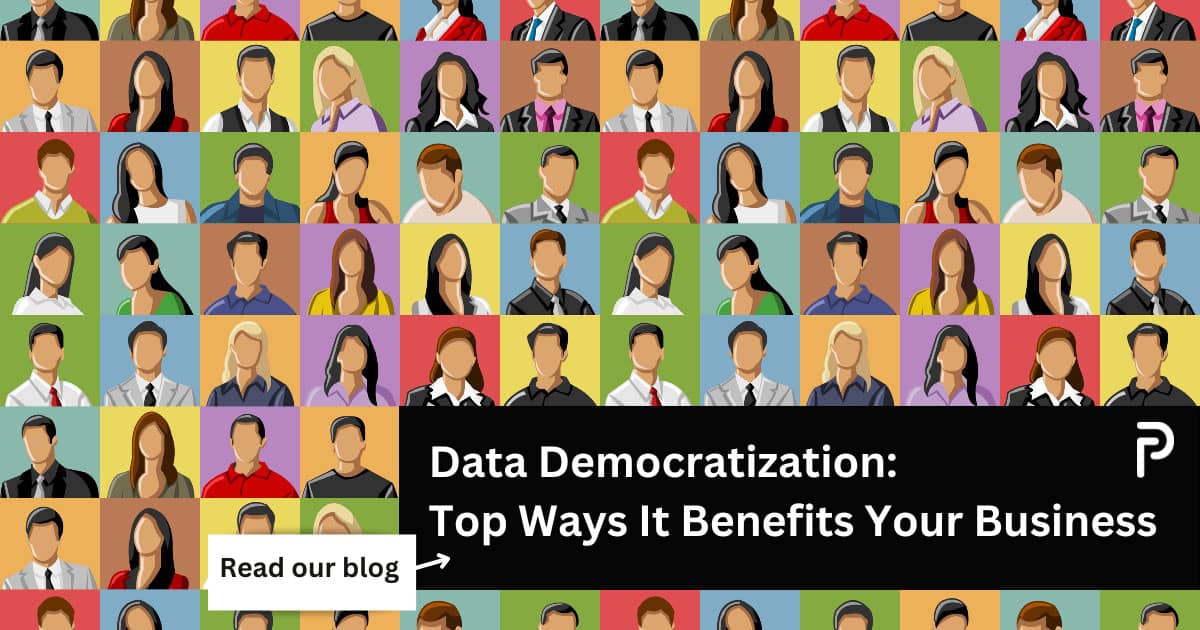What is data democratization? The digital age is defined by data and the concept of democratization of data. Most people assume data democratization is simply about making data available. This data democratization definition is a simplified concept that does not consider the full complexity of the subject.
Understanding how it works and why democratizing data is so beneficial can deliver real business benefits that act as an asset to your future growth.
By removing data from the hands of a few select analysts, you give data and all its uses to the masses—if you can do so in a responsible and compliant manner.
What Is Data Democratization?
At a base level, democratized data is the process of widening accessibility to data. Yet to make the most of your data democratization strategy, you need to go further.
As is the case for a democratic governmental system, the first step is to define a constitution—a set of rules whereby people need to operate in such a democracy.
The second big consideration is about data understandability. Just because you democratize data and everyone has access to data does not necessarily mean they know how to use it. This ongoing process makes data accessible and empowers teams to work with data comfortably, regardless of whether they have a technical background.
Your team should feel confident talking about data, tapping into it, and making decisions informed by data. Building customer experiences powered by data requires a group effort that can only come with true democratization.
But what are the principles of a data democracy?
- Compliance: Define what data can be accessed by which groups of users and under what conditions. A fine-grained access approach works best versus coarse grained. For instance, if Social Security Numbers (SSNs) should not be seen by everyone, then blocking access to all data containing SSNs isn’t good enough. You should find ways to mask SSNs or remove them from what the users can see rather than completely block access.
- Cataloging data: If the approach is to democratize all data in a responsible manner, the second principle is to provide an easy way for people to find data. The solution? Provide a centralized catalog of available data, whether the person has access to it or not.
- Empowering education: Make employees feel confident talking about and working with data. Many people with a non-technical background struggle with data, and they often hand over the responsibilities to a data analyst.
- Tool suite: Give everyone the tools they need to work with data. Break the silos that leave common data tools locked away within specific departments.
- Cultural shift: Organizations that are not used to democratization may need to consider a widespread culture shift. It could take months to build and integrate an efficient, effective democratization model. More importantly, a top-down commitment and encouragement to execute data-driven decision making processes is a critical starting point.
Bringing democratized data into an organization is no small feat, particularly if the foundations are not already in place. Committing to the model will require both investment and stakeholder buy-in.
How Does Your Team Use Data?
The digital era requires data to enable companies to perform all the functions necessary to deliver an exceptional customer experience and generate a profit. Even though many are unaware of it, data informs everything.
Every team will utilize data differently. While most would associate data use with analysts and tech-based organizations, even the smallest businesses must acquire strong data literacy and the tools necessary to maximize available data.
Data is digital gold. (With many now referring to data as the new oil.) Here is how different teams might use data.
- Marketing: Marketers use data to create engaging, compelling campaigns by finding out what encourages someone to click, share, or buy.
- Sales: Data plays a massive part in identifying the most likely prospects to buy. Sales agents will create buyer personas, dig into consumer activity, and use caches of previous data to discover which sales strategies have the most significant impacts.
- Customer Support: Offering support to customers is about finding the right solution and finding it quickly. Support teams can achieve faster resolutions by seeing what a user has and has not done with a product before getting in touch.
- Product Design: Products are there to overcome common customer pain points. Design and engineering teams utilize data to incorporate the features that increase customer value and remove the features that don’t.
- Executives: Executives need a firm understanding of data to grasp how a business is performing at any given moment. They will use data to assess future investments and their markets as a whole.
These are just high-level overviews of how different teams might use data to carry out their day-to-day functions. Modern data technology typically requires teams to have knowledge of several tools before they can start harvesting, interpreting, and extracting value from data.
Pros and Cons of Data Democratization
Why should launching a data democracy be a priority for business owners today?
Data democratization presents an opportunity for a fresh new view of how teams use data. Yet democratizing data also comes with its downsides.
Business owners must weigh up both sides of the democratization debate when deciding if this is the right strategy for their organizations.
Pros
- Gain a competitive advantage. A team that knows about data and how to derive insights and use it effectively will always have an edge on the team that shies away.
- Faster decision-making. Making data available to all and teaching them how to use it makes businesses better able to rapidly confront obstacles and other commercial challenges.
- Create better customer experiences. Every team will have an alternate view of the customer experience. Share these experiences while backing everything up with data.
- Empower employees to perform to their potential. Rather than waiting for an analyst to provide a report, employees can dip in and out of data tools whenever necessary.
- Save time and be more efficient by rethinking how to share and consume data across an entire company.
Cons
- Potential security concerns. Decision-makers need to act with caution when determining which data should be made available and to whom. Opening up the closed world of data initiates significant security concerns.
- Companies must make massive investments in education and ongoing training to ensure those of a non-technical background can participate in the new data democracy.
- Misinterpretation of data is another consequence of democratization. Those with a non-technical background might not have the skills or experience necessary to interpret the data available to them.
Integrating Data Democratization into Your Business
Building a data democratization strategy requires a tremendous amount of work and full buy-in from stakeholders. Identifying data challenges, maintaining compliance, and ensuring the resources necessary to initiate a widespread cultural shift are just some of the challenges businesses face, whether they want to democratize AI or ordinary website data.
So, how can democratizing data be integrated into a business safely and beneficially?
Identify the Organizational Investments
The first step is identifying the challenges of democratization of data and what an organization wants to get out of it. All companies have unique challenges they wish to overcome. Write down these goals and figure out where investments need to be made in software and employee training.
Establish a budget for this and determine whether now is an appropriate time to begin laying the groundwork.
Break Down Silos
Silos act as gatekeepers to data. Breaking these silos should be the first priority, as it is the key to employee empowerment.
Customizable analytics tools are critical to this process because they can desegregate and connect previously siloed data. Ensuring data is in one manageable place enables employees to begin accessing and working with data.
Choose the Right Tech Stack
Data needs to be defined and categorized before it becomes useful. Select tools that can filter the data and visualizations shared by each department.
Marketing managers, for example, will need to have access to tools that enable them to segregate customers and follow the buyer’s journey. A Chief Marketing Officer (CMO), however, will need devices that allow them to use data to analyze marketing ROI.
Look for tools that offer robust visualization features. Instant visualizations create comfort and make it easier for employees to interpret the data in front of them.
Initiate Team Training
With the correct tech stack, companies must train their teams in how to use them. Democratization depends on the principle of self-service analytics. In other words, every individual must have a minimum comfort level working with the tools available to them and integrating the results into their work.
Team training can take any preferred form. It may require bringing in an outsider to train a team or a session spent with the IT team.
Implement Checks and Balances
Like all democracies, data democracy must have checks and balances to prevent mismanagement and misinterpretation. Ensuring data governance and ongoing compliance with prominent protection regulations, such as General Data Protection Regulation (GDPR) and California Consumer Privacy Act (CCPA), is critical to the future of any organization.
Setting up a dedicated cross-departmental team to manage this process creates a center of excellence that ensures data remains accurate and secure.
Tools like Privacera can automate much of this process and streamline the way you enforce your data policies and regulations.
Be Willing to Change
To democratize data is not a simplified step-by-step process anyone can follow. Every company will come up against unique kinks and difficulties that will only become apparent during the implementation and integration stages.
Executives must pay close attention to any needed diversions in a data democratization strategy. Crafting a plan that fits a company’s goals, challenges, and philosophies requires an agile approach.
No single team can be fully responsible for the process of democratization. Companies must set up a central committee to manage the process and keep tabs on its progress.
Conclusion
Data governance and security are vital concerns when implementing data democratization within a business. However, the right data security platform can smooth out many of the wrinkles inherent in this ongoing process.
For next-generation data tools, including access control, AI-powered data discovery, and cutting-edge security and governance tools, choose Privacera. Harness the power of data now with the platform that is altering how companies worldwide use data.To find out more about how Privacera can simplify your democratization, request your demo now.





